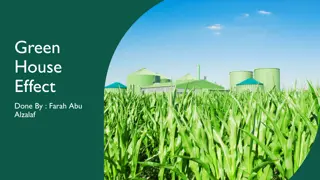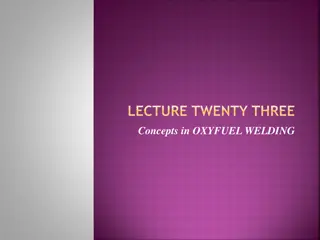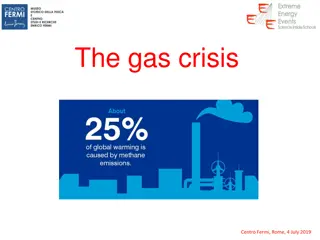Economic Framework for Greenhouse Gases: Recent Insights
A comprehensive analysis of the social cost of greenhouse gases, including recent RFF research and EPA estimates, using a stochastic discounting approach. Explore a modular framework for calculating the SCC and RFF Socioeconomic Projections on global CO2 emissions and economic growth. Learn about th
0 views • 17 slides
Understanding Human Contribution to Climate Change
Learn how human activities contribute to climate change by emitting greenhouse gases, leading to the greenhouse effect and global warming. Explore the impacts of climate change, recognize greenhouse gases, and comprehend the vital role humans play in influencing Earth's climate system through variou
1 views • 9 slides
Understanding the States of Matter: Solids, Liquids, and Gases
Matter is anything that occupies space and has mass, consisting of tiny particles like atoms and molecules. Solids have closely packed particles, liquids have less densely packed particles that can flow, and gases have spread out particles. Solids retain their shape, liquids take the shape of their
7 views • 11 slides
Understanding Properties of Gases and Gas Laws
Gases exhibit unique properties compared to solids and liquids, including compressibility and variable densities. Pressure is defined as force per unit area, with common pressure units like atm, mmHg, and torr. Gas laws such as Gay-Lussac's Law, Boyle's Law, and Charles's Law describe the relationsh
4 views • 33 slides
Understanding LEL Monitors and Gas Safety in Industrial Settings
A detailed explanation of LEL (Lower Explosive Limit) monitors and their importance in detecting combustible gases to prevent explosions in industrial environments. Learn how LEL monitors work, their role in ensuring safety, and the significance of regular testing for gas monitors to safeguard perso
4 views • 14 slides
Rising Industrialization in Africa Opens New Markets for Industrial Gases
Industrial Gases Market By Product (Oxygen, Nitrogen, Carbon Dioxide, Hydrogen, Argon, Acetylene, and Other Products), By Application, By Distribution, By End-User, By Region and Companies - Industry Segment Outlook, Market Assessment, Competition Sc
0 views • 5 slides
Biogas Production and Methane Content Measurement in Biodigester Research
Explore the process of collecting data in biodigester studies, focusing on biogas production, methane content, and related measurements. Learn how to read water levels, measure biogas, and assess methane content using sodium hydroxide or potassium hydroxide solutions. Practice techniques with fermen
0 views • 20 slides
Gas Behavior Review
Review key concepts related to the behavior of gases, including characteristics of gases, properties at standard conditions, the kinetic molecular theory, and factors affecting gas pressure. Test your knowledge with true or false questions and learn about gas compression, gas movement in aerosol can
0 views • 17 slides
Understanding Kinetic Theory of Gases: Key Concepts and Equations
Exploring the kinetic theory of gases, this content covers essential concepts such as ideal gas behavior, molar mass, the equation of state, and isobaric/isothermal processes. Discover the relationship between pressure, volume, and temperature in gases, along with practical examples and calculations
0 views • 49 slides
Understanding Convection Currents in Earth's Systems
Convection currents refer to the movement of heat by fluids like liquids and gases, transferring heat from one place to another. They play a significant role in the geosphere, atmosphere, and hydrosphere of the Earth, influencing phenomena such as plate tectonics, winds, and ocean currents. In the g
0 views • 12 slides
Types of Gases in Tunnelling & Gas Monitoring Sensors in TBM
Understanding the types of gases encountered in tunnelling is crucial for safety. Gases like carbon monoxide, carbon dioxide, nitrogen oxides, methane, and hydrogen sulfide are common in TBM environments. Proper gas monitoring sensor placement inside the TBM is essential to detect hazardous gas leve
0 views • 11 slides
Gas Chromatography Detectors: Flame Ionization and Thermal Conductivity
Gas chromatography detectors play a crucial role in separating and analyzing compounds in the pharmaceutical field. The Flame Ionization Detector (FID) utilizes hydrogen flame to ionize compounds eluted from the column, while the Thermal Conductivity Detector (TCD) principle involves converting elec
0 views • 13 slides
Exploring Ocean Water Chemistry: Salinity, Saltiest Body of Water, and Gases
Delve into the complexity of ocean water chemistry, including the significance of salinity levels, the saltiest body of water on Earth at Don Juan Pond in Antarctica, the composition of salts in ocean water, and the role of gases like oxygen and carbon dioxide. Discover how these factors shape the c
0 views • 11 slides
Gas Laws and Properties: Understanding the Behavior of Gases
Gas laws govern the behavior of gases and their properties in various conditions. From the total pressure of gas mixtures to calculating partial pressures, understanding the relationship between pressure, volume, temperature, and amount of gas is crucial. Effusion and diffusion play key roles in how
0 views • 16 slides
Exploring Properties of Matter: Solids, Liquids, and Gases
Dive into the characteristics of solids, liquids, and gases through engaging visuals and key vocabulary. Understand the behavior of particles in different states of matter and learn about the properties that define each state. Explore examples of solids, liquids, and gases with a focus on their uniq
0 views • 19 slides
Electrical Breakdown in Gases, Solids, and Liquids: Understanding the Phenomenon
Exploring the intricate dynamics of electrical breakdown in various mediums such as gases, solids, and liquids. From the criteria for breakdown in gases to factors affecting breakdown strength in liquid dielectrics, this study delves into the mechanisms, equations, and practical implications of thes
0 views • 15 slides
Chemical Properties and Bonding in Xenon: A Study of Noble Gases
Noble gases, including xenon, exhibit unique chemical properties due to their stable electron configurations. Xenon forms compounds like xenon difluoride, xenon tetrafluoride, and xenon hexafluoride, showcasing various hybridization states and geometries. These compounds illustrate the reactivity of
0 views • 18 slides
Understanding Activity and Fugacity in Gases
Fugacity of real gases can be measured, defining standard states in terms of fugacity. The relation between fugacity, activity, and molar concentration is explored, highlighting the ideal behavior of gases at standard states. Activity coefficients and deviations from ideal gas behavior are also disc
0 views • 30 slides
Insight into Kinetic Theory of Gases and Maxwell Velocity Distribution
The discussion delves into the kinetic theory of gases, highlighting the deviations from ideal gas behavior and the derivation of the Maxwell velocity distribution. It explores the intricacies of molecule-wall collisions, Maxwell's assumptions, the Gaussian distribution, and the concept of reversibl
0 views • 8 slides
General Lab Safety Rules and Guidelines
Ensure 100% accuracy in identifying and adhering to general lab safety rules. Key points include reporting all injuries, wearing eye protection, maintaining safety zones around machines, disposing of combustible materials properly, obtaining permission before using equipment, and recognizing broken
0 views • 12 slides
Understanding Fuels and Their Classification
Fuels are combustible substances that serve as a source of heat or raw material for various industries. They can be classified as natural or artificial, solid, liquid, or gaseous, and primary or secondary fuels. Primary fuels like coal and wood are directly used for heat, while secondary fuels are m
4 views • 88 slides
The Noble Gases: Properties, Sources, and Uses
The noble gases, including helium, neon, argon, krypton, xenon, radon, and Oganesson, are characterized by their low reactivity due to a complete electron configuration. They have diverse applications, such as forming inert atmospheres, medical treatments, and lighting technologies. Naturally occurr
0 views • 16 slides
Understanding the States of Matter and Properties of Gases
Matter can be classified into gas, liquid, and solid based on particle arrangement, shape, and motion. Gases in pharmacy are crucial for various applications like anesthesia and aerosols. Properties of gases include compressibility, pressure exertion, diffusion, and expansion. Gas laws such as Boyle
0 views • 22 slides
Stove Fire Safety Tips and Recommendations
Providing a hearth at the base of the stove, maintaining sufficient space from combustible materials, ensuring proper ventilation, installing smoke and carbon monoxide detectors, and regular cleaning of the flue/chimney are essential practices to prevent fire hazards when using a stove. Timber surro
0 views • 5 slides
Understanding Gases and Plasmas in the Atmosphere
Delve into the concepts of gases and plasmas in the atmosphere, exploring topics such as fluid pressure, buoyancy, and the unique properties of gases compared to liquids. Discover how the balance between kinetic energy and gravity determines the thickness of our atmosphere and why it is essential fo
0 views • 25 slides
Understanding the Greenhouse Effect and Its Impact
The greenhouse effect is the trapping of the sun's warmth in a planet's lower atmosphere, primarily by greenhouse gases like carbon dioxide and water vapor. These gases absorb and re-emit infrared radiation, which leads to an increase in temperatures. While carbon dioxide and water vapor are signifi
1 views • 13 slides
Understanding Kinetic Theory of Gases and Thermodynamics
Explore the fundamental principles of the kinetic theory of gases, including the five postulates and the relationship between macroscopic properties and microscopic phenomena. Delve into the concept of entropy and thermodynamics, along with the behavior of ideal and real gases. Gain insights into th
0 views • 116 slides
Understanding ISO Building Classifications for Insurance Rating
The ISO building classification system has been a cornerstone for insurance rating factors for over a century, categorizing buildings into six classes based on construction type. Learn about Frame Construction, Joisted Masonry, and Non-Combustible structures, their characteristics, and how they impa
0 views • 15 slides
Overview of Alternative Gases and Pressure Gas Welding in Oxyfuel Welding
Alternative gases to acetylene in oxyfuel welding, such as MAPP, propane, and natural gas, offer different characteristics and applications. Pressure gas welding (PGW) is a fusion-welding process that uses oxyacetylene gas and pressure to join metal parts without filler metal. The advantages, limita
0 views • 8 slides
Gas Testing and Hazardous Atmospheres: Preparation and Safety Guidelines
In environments with potential hazards, it is crucial to prepare for gas testing to ensure safety. This involves identifying the type of gas or atmosphere to be tested, understanding common gases, asphyxiants, irritants, and corrosives, and maintaining equipment for accurate testing. Hazardous atmos
0 views • 40 slides
Understanding Intermolecular Forces and Dispersion Forces in Molecules
Particle diagrams of liquids, solids, and gases reflect distinct arrangements due to intermolecular forces. The existence of substances as gases, liquids, or solids at room temperature is attributed to the forces between molecules known as intermolecular forces (IMF), with dispersion forces being th
0 views • 30 slides
Role of Gases in Organic Synthesis: A Comprehensive Overview
The presentation delves into the significance of gases in organic synthesis at standard temperature and pressure, focusing on reactions with atom incorporation for the synthesis of useful organic molecules. It covers various gases such as H2, O2, O3, CO, NO, N2O, SO2, Cl2, F2, discussing their advan
0 views • 23 slides
Addressing the Gas Crisis in Rome: Solutions and Strategies
The gas crisis at Centro Fermi in Rome on 4th July 2019 highlighted the need for reducing harmful gas emissions. Regulations have been in place since the 1990s to ban gases with high ozone depletion power. The European Community is progressively banning gases with high global warming power, leading
0 views • 8 slides
Understanding Matter: Solids, Liquids, Gases, and Fluids
Matter exists in various states - solid, liquid, gas, and fluid. Solids have atoms closely packed, liquids have more freedom but still cohesion, gases have atoms spread out, and fluids flow like liquids or gases. Mass density characterizes matter based on atom proximity. Gas pressure results from mo
0 views • 22 slides
Exploring the Fascinating World of Gases and Plasmas in Chapter 14
Delve into the intriguing realm of gases and plasmas as we transition from liquids in Chapter 13. Understand the dynamics of fluid pressure, buoyancy, and the unique characteristics that differentiate gases from liquids. Explore examples illustrating the concepts and ponder over the mysteries of our
0 views • 28 slides
Storage and Manipulation of Liquefied Gases with Dewars and Cryostats
Storage and manipulation of liquefied gases involve using specialized equipment like Dewars and Cryostats to minimize heat transfer and maintain low temperatures. Dewars, invented by James Dewar, are double-walled vacuum vessels designed to store liquefied gases with minimal losses. The use of vacuu
0 views • 11 slides
Understanding the Kinetic Theory of Gases and Ideal Gas Model
Explore the Kinetic Theory of Gases, the Molecular Model of Ideal Gases, and concepts like pressure, temperature, and heat capacity. Understand the fundamental properties of gases, including the distribution of molecular speeds and equations that describe gas behavior. Learn about the mole concept,
0 views • 23 slides
Understanding the Behavior of Gases: A Comparison of Real and Ideal Gases
This chapter delves into the behavior of gases, contrasting real gases with the ideal gas model. It explores the P-V-T relationships of gases, highlighting the differences between ideal and real gas behaviors based on molecular properties. The critical point where coexisting gas and liquid phases co
0 views • 40 slides
Addressing Compliance Challenges in Ottawa's Housing Sector
Ottawa's housing organizations face compliance challenges related to fire safety, including lack of code adherence, non-compliance issues, and legacy structural issues. Efforts to achieve compliance involve daily inspections, addressing combustible materials and obstructions, and obtaining funds for
0 views • 11 slides
Understanding Gases in the Environment and Their Impact on Earth
Gases such as CO, CO2, SO2, O2, and O3 play a crucial role in shaping our environment. This chapter delves into the properties of gases, the three states of matter, pressure exerted by gases, atmospheric pressure measurement methods, and units of pressure used in scientific fields.
0 views • 25 slides







































